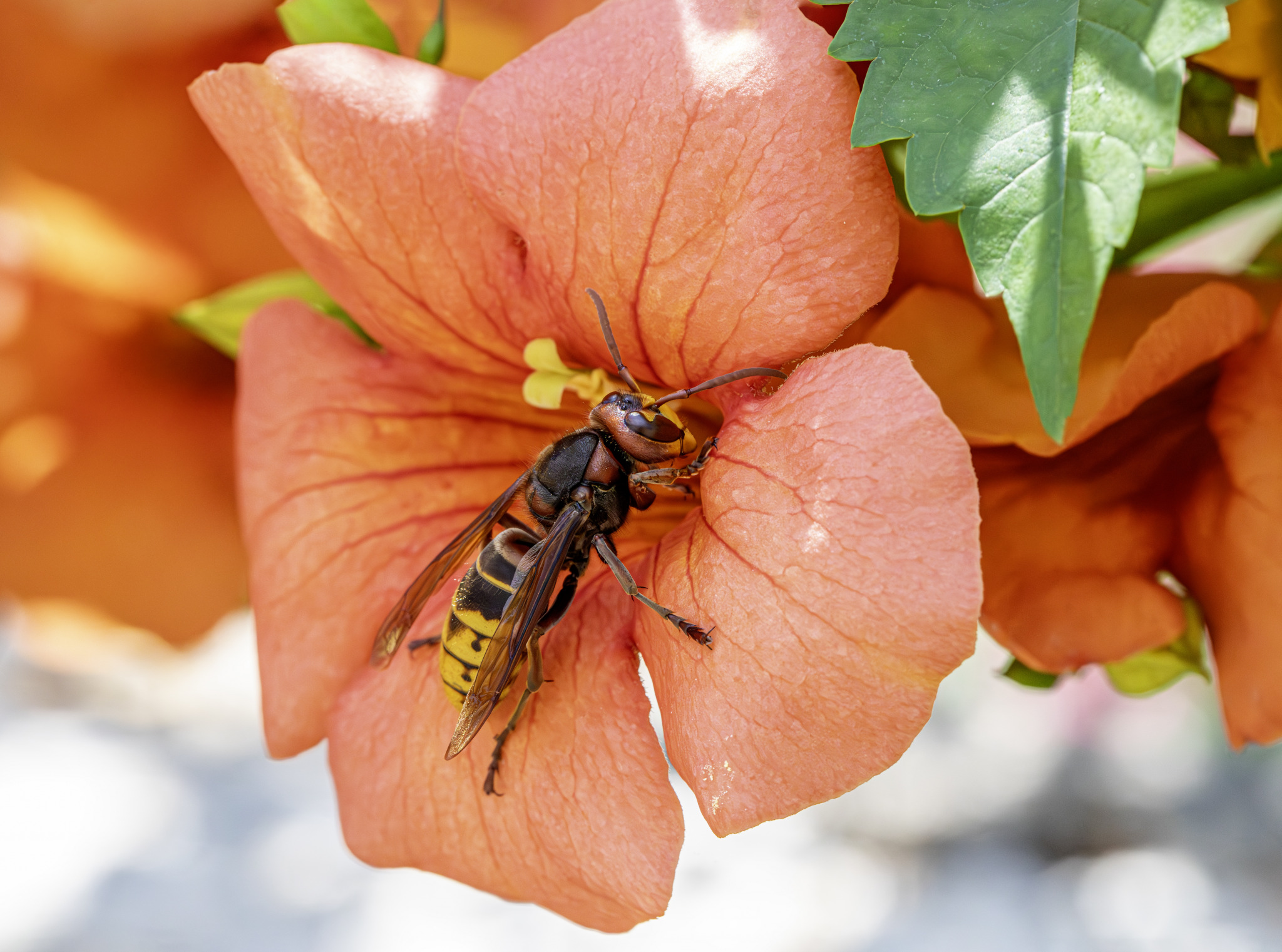The European Hornet (Vespa crabro) is a large and striking species of hornet native to Europe and parts of Asia. Known for its impressive size and potent sting, this hornet plays a significant role in its ecosystem as both a predator and scavenger.
Description
- Size:
- Length: Approximately 18-25 millimeters (0.7-1 inch), with queens being larger than workers.
- Wingspan: Around 30-35 millimeters (1.2-1.4 inches).
- Appearance:
- Coloration: The European Hornet has a distinctive appearance with a yellow and brown or orange striped abdomen. Its thorax is generally brown with yellowish stripes.
- Head: The head is large and predominantly yellow with prominent compound eyes and powerful mandibles.
- Wings: Its wings are translucent with a reddish-brown hue, and it has a noticeable reddish-brown “band” near the base of the wings.
Habitat
- Distribution: Native to Europe and parts of Asia, including the Middle East. It has also been introduced to parts of North America.
- Preferred Environment: The European Hornet prefers a variety of habitats including woodlands, forests, and suburban areas. It builds nests in sheltered locations like tree hollows, wall cavities, or under eaves of buildings.
Behavior and Ecology
- Nesting:
- Nests: Nests are typically constructed from paper-like material made by chewing wood fibers mixed with saliva. The nests are usually round or oval-shaped and can be quite large, housing several hundred individuals during peak season.
- Location: Nests are often found in sheltered, elevated locations such as tree trunks, roof spaces, or wall cavities.
- Feeding:
- Diet: European Hornets are omnivorous. They feed on a variety of substances including nectar, fruit, and meat. They are also known for preying on other insects, including other wasps and bees.
- Role: As predators, they help control populations of other insects. They also contribute to the pollination of plants.
- Social Structure:
- Colony: The colony is led by a queen, who is the sole egg-laying individual. Worker hornets, which are sterile females, maintain the nest, forage for food, and protect the colony. Males, or drones, are produced later in the season and are primarily involved in mating.
- Life Cycle:
- Spring: In early spring, the queen emerges from hibernation and starts a new nest. She lays eggs that hatch into larvae, which eventually become adult workers.
- Summer: The colony grows with the addition of new workers. As the season progresses, the colony produces new queens and males.
- Autumn: After mating, the new queens hibernate, while the old queen, workers, and males die off. The cycle starts anew in the spring.
- Behavior:
- Aggression: European Hornets can be aggressive if their nest is threatened. They have a painful sting, which they use as a defense mechanism. Unlike bees, hornets can sting multiple times.
- Activity: They are generally more active during the day and are less aggressive outside of their nesting area.
Conservation
- Status: The European Hornet is not currently considered endangered and is classified as Least Concern by the International Union for Conservation of Nature (IUCN). It is a common species in its native range.
- Impact: In some areas, particularly where they have been introduced, they can have a negative impact on local insect populations and be a nuisance to humans.
Observing European Hornets
- Best Times: They are best observed during the warmer months, especially from late spring to early autumn when they are most active.
- Watching Tips: Observe from a safe distance, particularly if you are near a nest. Their nests can be quite large and are often located in elevated or concealed areas.
Interesting Facts
- Sting: The sting of a European Hornet is quite painful but generally not life-threatening to most people. However, allergic reactions can occur.
- Size: The European Hornet is one of the largest hornets in Europe, making it easily recognizable compared to other wasps and bees.
Summary
The European Hornet (Vespa crabro) is a prominent species of hornet known for its large size, striking coloration, and potent sting. Found across Europe and parts of Asia, it plays an important ecological role as a predator and scavenger. While generally not aggressive, it can become defensive if its nest is threatened. Its impressive nest-building skills and complex social structure make it a fascinating subject for study and observation.
Visited 844 times, 5 visit(s) today
Views: 1302
Subscribe to the newsletter:
